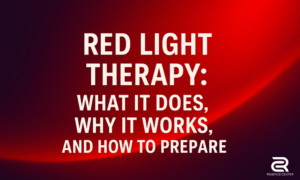Did you know that Lyme disease can be treated with red and Infrared light therapy?
While antibiotics can treat Lyme disease if it is caught quickly, it becomes much harder to treat the illness if you wait too long to go to the doctor or if it is not caught in a timely fashion.
In addition, some people cannot take antibiotics and others can develop post-treatment Lyme disease Syndrome (PTLDS), which is dangerous and hard to treat. Those with this condition often look for other treatment modalities.
Both Lyme disease and PTLDS have underlying causes of inflammation, which both red and Infrared light therapy are great at treating. Below, you will learn all about Lyme disease and how red and Infrared light therapy are effective treatment modalities.
WHAT IS LYME DISEASE?

Lyme disease is an inflammatory disease caused by the bacterium Borrelia burgdorferi or (rarely) Borrelia mayonii. First diagnosed in the 1970s in Lyme, Connecticut, Lyme disease can develop in humans who are bitten by infected blacklegged ticks.
In its early stages, Lyme disease causes flu-like symptoms including rash, fever, chills, nausea, and joint aches. Catching Lyme disease at an early stage is critical because it grows progressively worse and symptoms will become more serious. If Lyme disease is caught early enough, patients may be successfully treated with antibiotics. “People treated with appropriate antibiotics in the early stages of Lyme disease usually recover rapidly and completely,” says the Centers for Disease Control and Prevention (CDC).
Usually, it takes two to four weeks for Lyme disease sufferers to recover after taking antibiotics. However, according to the CDC, in a small number of cases, antibiotics are not completely effective for people with Lyme disease. In these instances, a chronic form of the disease, known as post-treatment Lyme Disease Syndrome (PTLDS), may develop.
CHRONIC LYME DISEASE (PTLDS)
PTLDS is a serious, potentially life-threatening condition that results when the Lyme disease infection has spread to the heart, nervous system, and joints. Symptoms include neurological problems, extreme fatigue, heart arrhythmia, liver inflammation (hepatitis), neuropathy, and a condition known as Lyme arthritis, which is chronic joint inflammation.
Scientists aren’t actually sure why some people develop PTLDS. The prevailing theory is that the bacteria can trigger an auto-immune response that has lasting effects even after the original infection has been cleared up. When you have PTLDS, your liver and kidneys become overworked as they attempt to clear out the invading bacteria. Slower-than-normal detoxification can lead to a build up of toxins that stress the other organs—and a ripple effect of unwanted symptoms quickly follows.
Another complication brought on by PTLDS is chronic inflammation, which may be caused by:
- Antibiotic-resistant bacteria that linger in the body.
- Lyme-disease-related autoimmune disorder, in which the immune system malfunctions and begins attacking the body instead of the invading pathogens.
- Mitochondrial dysfunction, which occurs when structures inside cells that produce energy for the cells malfunction.
NEED FOR ALTERNATE TREATMENT FOR LYME
People with Lyme disease who are unable to take antibiotics, or who developed PTLDS because antibiotics were not effective, are often desperate to find a treatment that works.
According to the CDC, patients with PTLDS usually get better over time, but many months can pass before they feel completely well and comfortable.
Ideally, they will want to find a treatment that supports the body’s detoxification processes, stimulates normal cell activity, and reduces inflammation. Luckily, there are two methods available today that help achieve these functions: heat and light!
INFRARED SAUNA THERAPY

Doing Infrared Sauna for Lyme Disease can be beneficial. Regenus Center offers Infrared sauna therapy.
When Lyme disease infects a person’s bloodstream, toxins build up. Thankfully, healthy heat from a infrared sauna may help to detoxify the body and expel the toxins that currently inhabit your body. Infrared saunas are one of the most effective methods for detoxification, as the toxins are expelled through sweating.
Saunas produce enough heat to make the body a less welcoming host for bacteria by raising the body’s core temperature and encouraging profuse sweating, which releases toxins through the skin. This reduces the burden on the liver and kidneys.
Saunas increase blood flow to aid with the detoxification process and to bring needed nutrients to all parts of the body. Saunas also activate heat shock proteins. These proteins are produced by cells in response to stressful conditions (such as heat) but they are now known to be present during wound healing or tissue regeneration. Activating these proteins artificially, via heat, can help stimulate the healing process. According to Dr. Lawrence Wilson, author of Sauna Therapy, infrared light penetrates deeply into the tissues to quickly remove neurotoxins and accelerate the healing process.
By using an infrared sauna, you are using a non-toxic way to help lessen the effects of an unfortunate disease. Infrared heat has also been shown to relax tense muscles, which promotes overall pain relief on your body, and in your muscles and joints.
RED LIGHT THERAPY ALSO KNOWN AS PHOTOBIOMODULATION (OFFERED AT REGENUS CENTER)

Red light therapy for Lyme Disease
Natural sunlight has been used for thousands of years to promote health and healing, and is invaluable. In fact, no living thing could survive without the sun. But as beneficial as sunlight is, too much can be risky, causing premature aging, damage to the skin, and skin cancer.
It may seem unbelievable that you can help alleviate even some symptoms of a serious bacterial illness like Lyme disease with light.
But if you use the correct wavelengths of light, delivered at the correct power setting, you might be surprised at how effective it is.
To understand this concept, let’s look at some interesting basics about light for therapeutic uses. Scientists have identified the specific therapeutic properties of each wavelength of light, which are measured in nanometers (nm). Of the visible and invisible wavelengths of light, red and NIR light have the broadest range of benefits throughout the body.
For example, red light from 630nm to 660nm has been shown to be an effective aid for facial rejuvenation, non-melanoma skin cancers, neuropathic pain, and wound healing.
Near-infrared wavelengths between 810nm and 850nm are technically part of the infrared light spectrum.
Because these wavelengths can penetrate much deeper into the body than red light, NIR light can also be used for post-exercise recovery, stroke recovery, and reduction of oxidative stress in the brain, among numerous other conditions.
The most significant benefits come from the combination of red and NIR wavelengths because red light penetrates the outer layers of skin, whereas NIR light penetrates into bone, muscle, organs, and connective tissue.
Many lymph nodes, for example, are just below the skin’s surface and can be stimulated by the shorter wavelengths of red light. To stimulate the lymph nodes deeper in the body, the deeper reach of NIR wavelengths is necessary.
Red light therapy is an umbrella term for light therapy using red and NIR wavelengths. Also called photobiomodulation and low-level light therapy (LLLT), red light therapy is clinically proven to help the body recover from a variety of conditions because it powerfully supports the body’s own healing mechanisms.
In other words, LLLT helps the body heal from the inside out, rather than just providing relief from symptoms.
Specifically, red light therapy improves cellular functioning and reduces chronic inflammation. Optimal systemic functioning begins at the cellular level, and peak cellular functioning is supported by a reduction in inflammation.
WHICH IS MORE EFFECTIVE – HEAT OR RED INFRARED LIGHT?
Heat, whether it comes from a traditional or infrared sauna, is both a stimulating and destructive force. Heat causes additional stress to the body.
While the stress is temporary and the stress can lead to accelerating healing, the heat itself can cause damage when not used with caution. Both heat and red light can help Lyme Disease sufferers.
If you are choosing between them, you will probably get more powerful and lasting results with light therapy.
Light is a stimulating force that does not stress the body but rather, promotes healthy cell functioning, without any known side effects.
Red light therapy reduces inflammation and promotes healing from within.
It does this by:
- Stimulating mitochondrial activity
- Boosting production of stem cells, which are non-specialized cells that have the ability to develop into many different cell types including brain cells, muscle, and other soft tissue
- Improving thyroid health (thyroid hormones modulate the immune response.)
- Promoting liver regeneration
- Red light also eases the symptoms of Lyme disease including Lyme arthritis, a painful and debilitating condition that results from inflammation of the joints, usually the knees.
To date, this Lyme arthritis study is the only study specially conducted on the effects of red light therapy on Lyme disease.
But given the broad range of therapeutic benefits, and the vast number of conditions that red light therapy is known to effectively help, it is reasonable to conclude that it could help you if you suffer from Lyme disease.
In an age where more and more bacteria are becoming antibiotic-resistant, it’s a good idea to seek out effective alternative therapies.
That does not mean you should avoid taking antibiotics—never avoid or stop any treatment unless directed by a doctor. But given the limited effectiveness of antibiotics in completely eradicating symptoms, red and near-infrared light therapy for Lyme disease can be a powerful complementary therapy for someone who suffers from it.
General Disclaimer: These services are not intended to diagnose, treat, cure or prevent any disease. This Website offers health and fitness advice. This advice is designed for educational purposes only and is not intended to replace the advice, treatment, or diagnosis of a healthcare professional. Always consult your physician before beginning any therapy program. You agree that you assume all responsibility when choosing to act on any of the health or fitness advice contained on this Website. We reserve the right to amend this policy at any time without any prior notice to you.





